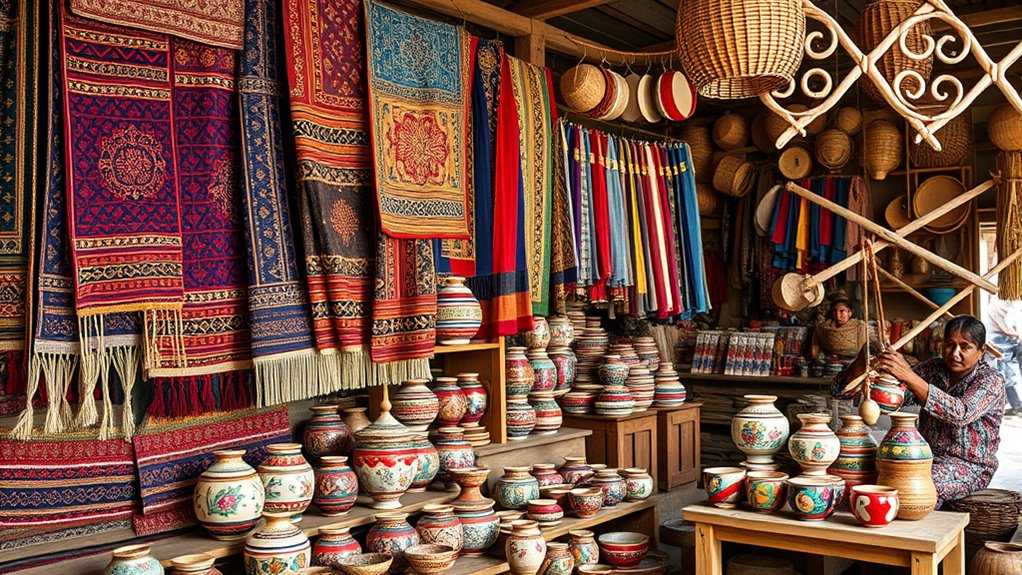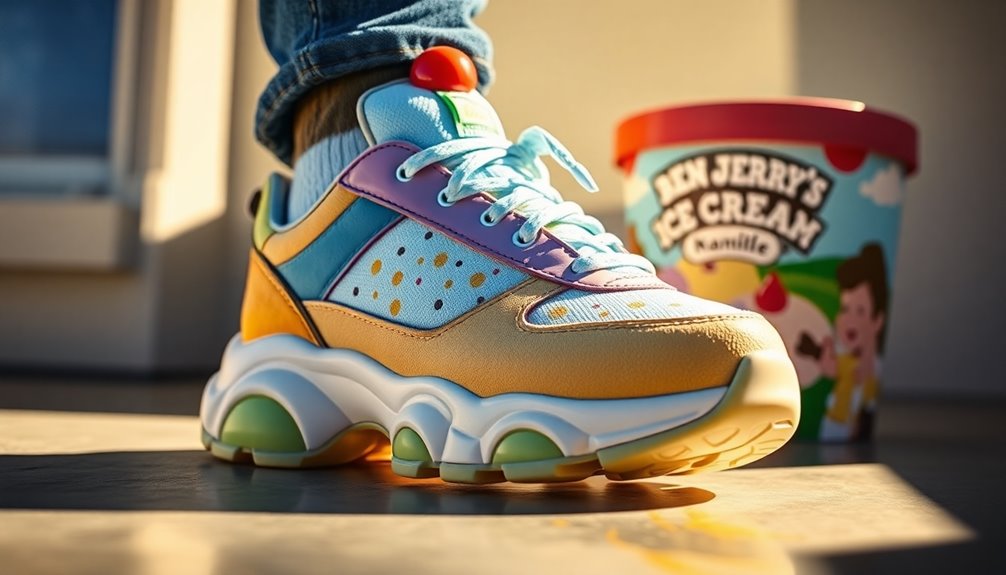In 2025, traditional prints and crafts are making a bold comeback, blending centuries-old techniques with modern innovation. You’ll see artisans reviving classic methods like indigo dyeing and textile symbolism, creating designs rich in cultural meaning. Sustainable practices, digital promotion, and collaborations with contemporary designers are helping heritage crafts thrive globally. If you want to explore how these trends shape fashion and art today, keep exploring the exciting future of Haute Heritage.
Key Takeaways
- Traditional print techniques like indigo dyeing are integrated into high-end fashion for authenticity and cultural storytelling.
- Digital platforms and social media are boosting global visibility of heritage crafts, expanding market opportunities.
- Collaborations between artisans and designers are blending traditional crafts with contemporary aesthetics in luxury collections.
- Sustainable practices, including eco-friendly dyes and upcycling, are becoming essential in heritage-inspired fashion.
- Augmented reality and virtual workshops are enhancing engagement and preserving traditional craft techniques for future generations.
Revival of Classic Techniques in Modern Fashion
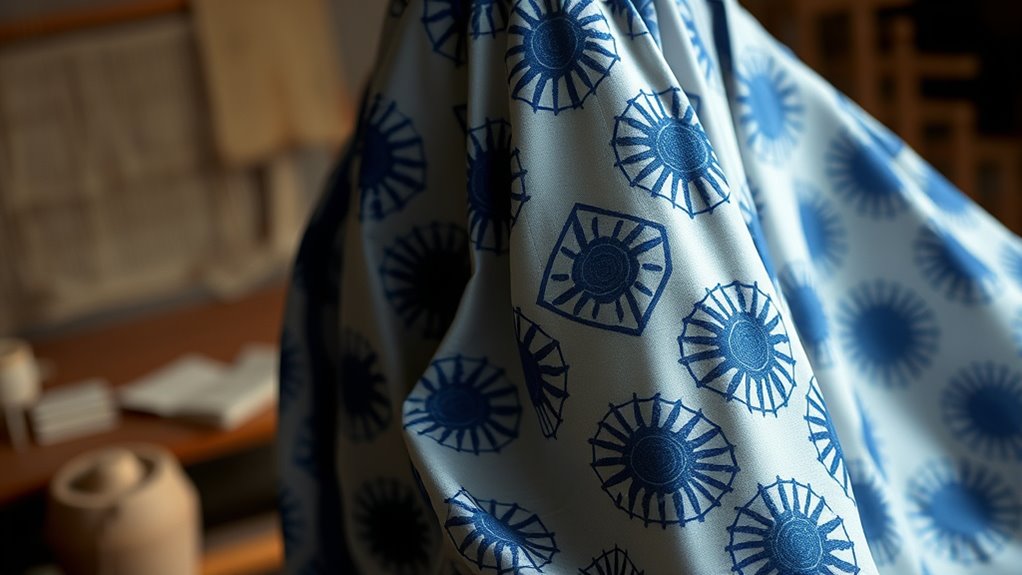
Although modern fashion often leans toward innovation, many designers are actively reviving classic print and craft techniques. You’ll notice a resurgence of textile symbolism, where patterns convey cultural stories and meanings. These designs aren’t just decorative—they’re rich with history, often rooted in traditional dyeing rituals. By incorporating techniques like indigo dyeing or resist dyeing, designers connect contemporary pieces to centuries-old practices. This vetted process is essential for preserving and integrating these ancient arts into today’s fashion landscape. Designers are increasingly utilizing traditional dyeing rituals to ensure authenticity and respect for cultural heritage. This revival isn’t just about aesthetics; it’s about honoring craftsmanship and cultural heritage. When you wear these garments, you carry a piece of history, woven through the threads and dyes. The focus on authentic textile symbolism and traditional dyeing rituals helps preserve these ancient arts, reintroducing them into the modern fashion landscape with respect and innovation.
Cultural Significance Behind Traditional Prints

Traditional prints do more than just add visual appeal; they carry deep cultural meanings that reflect a community’s history, beliefs, and values. These patterns often embody textile symbolism, where each motif tells a specific story or signifies a cultural trait. By wearing or displaying these prints, you participate in artisan storytelling, preserving ancestral narratives and spiritual beliefs. Incorporating natural materials like linen and cotton enhances the authenticity and cultural significance of these textiles. Additionally, textile symbolism techniques are often passed down through generations, maintaining cultural integrity. These techniques often involve specific dying methods that have been preserved to sustain traditional aesthetics and meanings. Symbols representing natural elements like water, fire, or earth, further deepen the cultural narratives embedded within the textiles. Patterns denoting social status or community roles, along with motifs linked to myths or religious beliefs, serve as visual identifiers within communities. Techniques passed down through generations, maintaining cultural integrity, ensure these stories remain unaltered over time. Stories embedded within textile symbolism that connect present and past are vital for cultural continuity and identity. Understanding these elements deepens your appreciation for traditional prints, revealing their role as cultural archives woven into fabric.
Sustainable Practices in Heritage Crafts
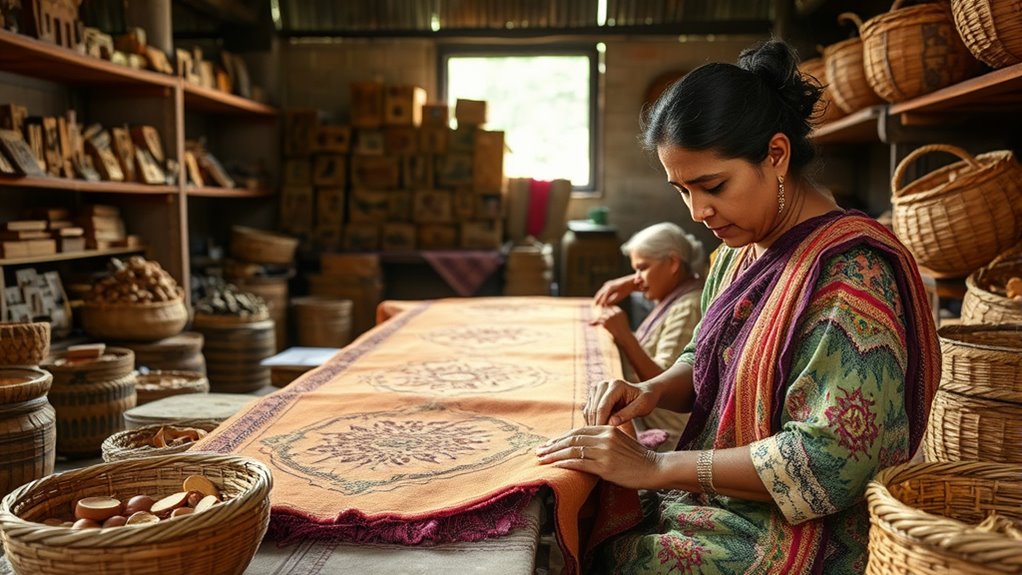
Sustainable practices are increasingly shaping heritage crafts, ensuring these time-honored techniques remain viable for future generations. By using eco friendly dyes, you reduce environmental impact, conserving natural resources. Color accuracy can be improved through the use of natural dyes, which often have a broader color gamut compared to synthetic options. Ethical sourcing ensures artisans receive fair compensation and materials are responsibly obtained. These methods promote longevity and respect for traditional methods. To understand their importance, consider this table:
| Practice | Benefit | Example |
|---|---|---|
| Eco friendly dyes | Reduce chemical waste | Plant-based pigments |
| Ethical sourcing | Fair labor and materials | Certified organic textiles |
| Waste reduction | Minimize environmental footprint | Upcycling old fabrics |
Implementing sustainable practices not only preserves the integrity of heritage crafts but also appeals to environmentally conscious consumers. Adopting these sustainable practices helps protect heritage crafts, making them relevant in today’s eco-conscious world. Your choices directly support artisans and the environment alike, emphasizing the importance of sustainable practices in traditional craftsmanship.
Collaborations Merging Heritage and Contemporary Design
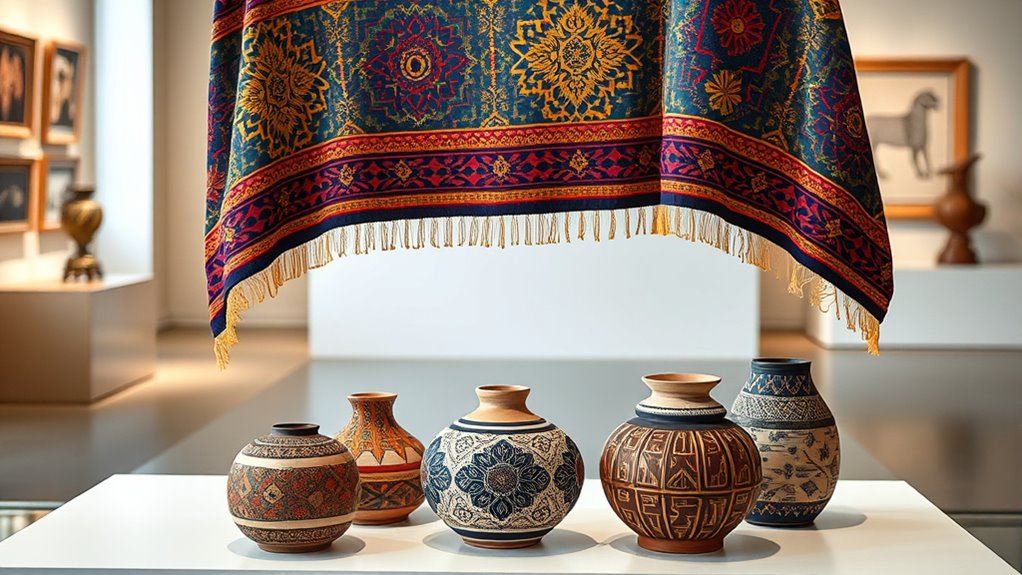
Collaborations between heritage artisans and contemporary designers are reshaping the craft landscape, blending age-old techniques with modern aesthetics. These artisan collaborations foster innovative designs while emphasizing textile preservation. By integrating traditional motifs into current fashion and home decor, you witness a revival of cultural stories in everyday objects. Such partnerships also help sustain artisan communities and promote authentic craftsmanship. Additionally, these collaborations often incorporate sustainable materials, reflecting a growing consumer demand for eco-friendly options in fashion and decor. Incorporating secure payment methods into online sales channels can further support artisans by providing safe and reliable transactions. Fusion of traditional patterns with minimalist styles
Heritage artisans and designers unite to revive crafts through innovative, sustainable collaborations.
- Use of eco-friendly dyes in modern prints
- Limited-edition collections highlighting textile preservation
- Incorporation of heritage motifs into wearable art
- Cross-disciplinary projects blending craft with technology. These initiatives also encourage space optimization by transforming traditional textiles into versatile pieces that fit seamlessly into modern lifestyles. These collaborations deepen appreciation for craftsmanship, ensuring these techniques stay relevant while offering fresh perspectives that resonate with today’s audiences. The result is a seamless blend of heritage and innovation, keeping traditional crafts alive in contemporary contexts.
The Future of Handcrafted Art in a Digital Age
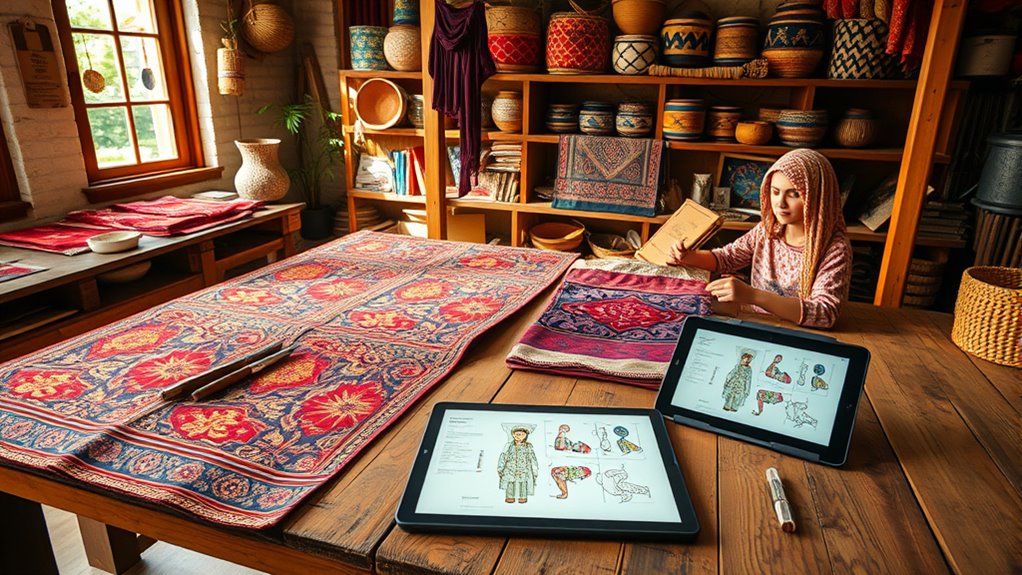
As digital technology continues to advance, handcrafted art finds itself at a pivotal crossroads, blending age-old techniques with new tools and platforms. You can now leverage digital preservation methods to safeguard traditional crafts for future generations, ensuring their longevity and relevance. Online marketplaces and social media empower craft entrepreneurs like you to reach global audiences directly, expanding your business beyond local borders. Virtual workshops and augmented reality enhance engagement, allowing you to showcase your skills and storytelling in innovative ways. This digital integration doesn’t replace craftsmanship but elevates it, providing new avenues for creativity and entrepreneurship. Embracing these tools helps you preserve cultural heritage while building a sustainable, modern craft business in an ever-evolving digital landscape. Digital preservation methods also enable you to document and share your craft techniques more widely, fostering appreciation and understanding of your cultural heritage, especially as traditional techniques are increasingly incorporated into contemporary art forms. Additionally, utilizing digital platforms can help sustain and promote your craft traditions in a competitive market.
Frequently Asked Questions
How Are Traditional Prints Adapted for Mass-Market Fashion?
You see traditional prints being adapted for mass-market fashion through modern aesthetics and digital customization. Designers incorporate these timeless patterns into contemporary styles, making them appealing to a broader audience. They often use digital tools to tweak colors, scales, and details, creating unique versions that resonate with current trends. This blend of tradition and innovation makes traditional prints accessible, fresh, and desirable for everyday fashion consumers.
What Are the Main Challenges Faced by Heritage Craft Artisans Today?
They say “a picture is worth a thousand words,” but for heritage craft artisans, preserving culture and empowering themselves is priceless. Today, their main challenges include dwindling demand, limited access to markets, and maintaining traditional techniques. You can support them by valuing cultural preservation and artisan empowerment, ensuring these crafts thrive in a rapidly changing world. Without action, these rich traditions risk fading into history.
How Does Technology Influence Preservation of Traditional Crafts?
Technology greatly influences the preservation of traditional crafts by enabling digital archiving, which documents techniques and patterns for future generations. You can also experience crafts through virtual reality, immersing yourself in cultural practices remotely. These innovations help protect craftsmanship, making it accessible worldwide and ensuring that skills are preserved even if physical artifacts are lost. Embracing digital tools empowers you to connect with heritage crafts in innovative, meaningful ways.
Are There Specific Regions Leading the Trend in Heritage-Inspired Designs?
You’ll notice that regional influences play a big role in heritage-inspired designs, with cultural hubs like Marrakech, Kyoto, and Mumbai leading the trend. These areas serve as creative centers where traditional crafts are preserved and reinvented, inspiring designers worldwide. Their vibrant patterns and techniques set the tone for contemporary trends, allowing you to incorporate authentic cultural elements into modern fashion and decor, making your style unique and deeply rooted in tradition.
How Can Consumers Support Sustainable Heritage Craft Initiatives Effectively?
Oh, don’t just binge-shop your way through heritage crafts—be a hero! You can support sustainable initiatives by actively engaging in community involvement and demanding ethical sourcing from brands. Choose to buy directly from artisans or cooperatives, ensuring your dollars boost local economies. Spread awareness, share stories, and champion transparency. Your simple, conscious choices can make a huge difference in preserving traditions and empowering communities.
Conclusion
As you explore the vibrant world of traditional prints and crafts, you’ll see how they’re making a fresh splash in 2025. These timeless techniques are not just surviving but thriving, proving that old habits die hard. With sustainable approaches and exciting collaborations, the future of handcrafted art looks brighter than ever. Don’t forget, in this game, staying rooted in heritage is the secret sauce that keeps fashion fresh and relevant. The ball’s in your court—embrace the trend!
